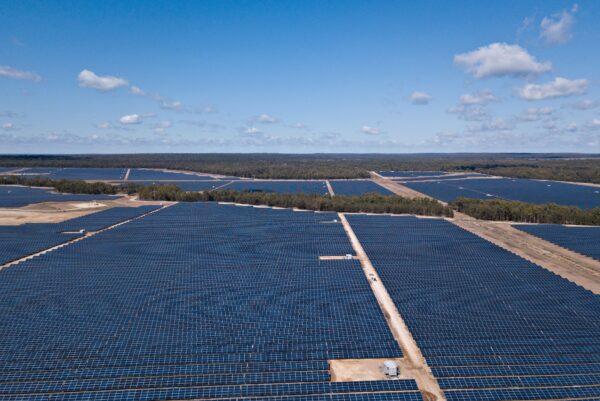Origin Energy has announced plans to shut down Australia’s biggest coal-fired power station in 2025—seven years earlier than originally scheduled—with plans for the southern hemisphere’s biggest battery to make up part of the loss.
Coal powers more than two thirds of the state of New South Wales’ (NSW) energy demand, with the Eraring coal plant producing 2,880 MW (megawatts) of power alone—equivalent to 28 percent of the state’s capacity from its remaining five coal plants.
Origin CEO Frank Calabria explained that one of the primary reasons for the closure was cost, with the ageing coal plant requiring increasing maintenance while cheaper solar farms sprouted across the nation.
Origin is considering replacing the coal plant with a large battery, with the company as a whole transitioning to renewables and to gas, with its ability to provide “peaking” power for durations when wind and solar output is low.

The NSW state government has also stepped up, announcing the southern hemisphere’s biggest battery, the “Waratah Super Battery,” to help replace the loss.
When fully charged, the battery will be capable of outputting at 700 MW—one quarter of Eraring’s capacity—for a maximum of two hours.
The Australian Energy Market Operator (AEMO) had already predicted coal could retire three times faster than expected, and reassured more transmission cabling would better connect the state’s scattered array of solar and wind farms.
By 2050, the AEMO estimates the National Electricity Market’s transition away from carbon dioxide-emitting power would require 10,000 kilometres of new transmission—enough to span one quarter of the way around the Earth.

Madeline Taylor, a senior lecturer at Macquarie University School of Law and member of climate change communications organisation, the Climate Council, said that renewable energy would dominate Australia’s energy landscape given the influx of investment directed towards reaching net zero emissions.
“Some of Australia’s biggest power companies are not able to compete from a price perspective and policy perspective, as the states and territories cash-in on a net zero future, bringing with it cheaper renewable power, economic investments, and new clean jobs,” Taylor said in an email to The Epoch Times.
Fears of Energy Instability
Concerns have grown that a rapid transition to more intermittent forms of power generation, such as wind and solar, could undermine Australia’s energy security.Federal Energy and Emissions Minister Angus Taylor argued that the loss of “dispatchable” power—that is, power available on demand—should be similarly replaced with more dispatchable energy.
“We’re seeing record levels of investment in household solar in particular ... but it’s got to be dispatchable behind it and if there’s not, then the lights go out and the prices go up now,” he said.

Eraring is the third coal plant to announce an earlier closure, with the 1,680 MW Liddell coal-fired power station closing shop in 2023, and the 1,600 MW Hazelwood power station which exited in 2017.
The unexpected and short-notice shutdown of Hazelwood caused disruption across Australia’s east coast, with average energy prices shooting up by 85 percent for Victoria, 63 percent for NSW, 53 percent for Queensland, and 32 percent for South Australia.
For Liddell, the federal government has intervened and commissioned a $600 million, 660 MW gas plant in its stead, but Taylor said he was let down by the similar move for Eraring.
Concerns for Coal Workers
Origin CEO Calabria said he understood the move would see a loss in high-skilled jobs, and that the company was aiming to support those involved.“Eraring is a high-quality asset, run by a skilled and dedicated team, that has worked tirelessly to supply reliable and affordable energy in NSW for four decades,” Calabria said.
“We acknowledge this news will be challenging for many of our colleagues, suppliers and the local community. This is only the start of the process, and we commit to consulting with our people, and supporting them, through any potential closure.”
In particular, the committee recommended the NSW government invest in programs capable of re-skilling the existing coal workforce and providing education and training for an emerging renewables sector.

Non-profit free market public policy think, the Institute of Public Affairs (IPA), warned that Eraring’s one thousand workers would be one of the first to be brushed aside as Australia shifted from traditional coal plants.
“These job losses are just the beginning. Entire regional towns across NSW and Queensland will be decimated by net zero emissions”, said Daniel Wild, director of research at the IPA.
Research conducted by IPA previously had identified that up to 653,600 jobs would be put at risk by Australia’s zero emissions policy, with jobs lost across agriculture, coal mining, and heavy manufacturing.
“Sadly, today’s announcement confirms this research,” IPA said in a statement.
Wild pointed out that efforts to reduce emissions had been overshadowed by a dependence on China for its solar panels—with 90 percent of Australia’s panels coming from the communist country—made using its growing fleet of coal-fired power plants.
The Cost of Quick and Cheap Solar Energy
Worries have grown that coal’s replacement with cheap solar panels comes as a consequence of Australia’s majority imports from China, a country that has been accused of using slave labour in its supply chains.A report released by the Australian Human Rights Commission highlighted worrying reports of China’s enslavement of millions of ethnic Uyghur, Kyrgyz, and Kazakh citizens, many of whom have been found to be involved in the solar supply chain.
This includes some of the world’s most notable solar panel manufacturers.
United Australia Party Leader Craig Kelly suggested that the cost of solar—which is estimated to be the cheapest form of energy in Australia—is able to do so, in part, due to the exploitation of cheap labour.





